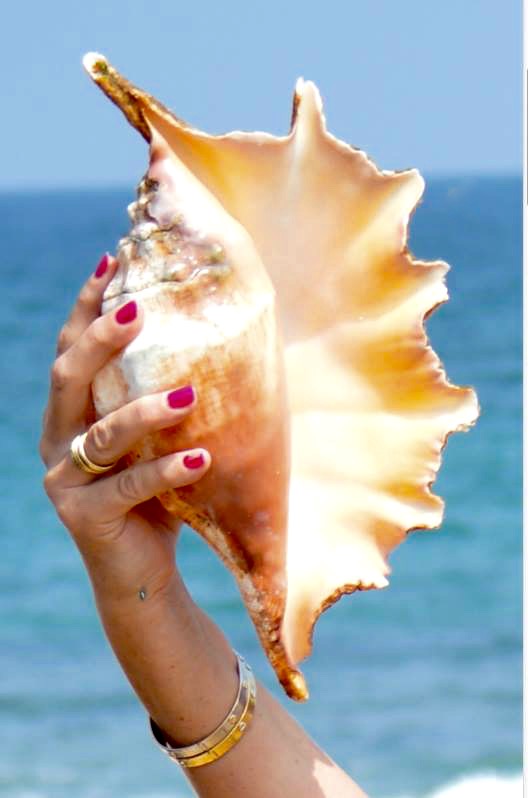Out of the shells I have found, the Lambis family are beautiful specimens of molluscs.
Never expecting to find anything but broken ones, given their size, imagine, when one day, walking along a rock shelf at low tide, I spied a vivid pink, shiny blob on the dull rocks in the distance. Deep down, knowing what it could be, hoping against hope it was intact, I crabbed across the slippery rocks in record speed.

Look closely and you can see the fly buzzing around my arm, this beauty was pretty high…
There, lying on the rocks was a near-perfect specimen, just waiting for me. The last high tide had cast it up. Picking it up, I realised its mollusc was still at home, sadly and smellily deceased. Followed by an army of flies, I called my shell partner over and said inhabitant was buried at sea. The euphoria of the find dissipated the terrible smell on the two hour drive back to Dubai…

Lambis truncata sebae , now clean and my largest self-collected shell….L: 30cm, W: 15cm
Since then, on Indo-Pacific travels, beached lambis seem to fall into my field of vision. I have quite a collection of variations found on such diverse shores as Indonesia, Borneo, Vietnam and Sri Lanka.
In Asia, lambis is food in the fishing villages, sadly a smashed shell is often all that remains on the beach, but often the smaller ones are thrown overboard once netted and a fishing village shoreline is often the place to find some .
Arabian Lambis:
In Arabia, two types are documented (it’s a fairly vast and diverse family) Lambis Lambis, according to Bosch (Seashells of Eastern Arabia) listed by Melvil and Standen,1901:381 from Muscat, but not found since.I have found these in other Indo-Pacific areas, but not in Arabia.
Lambis truncata sebae (Kiener,1843) is the other Arabian Lambis. Huge shells that can grow to 350mm, they have a heavily glazed parietal wall with the outer lip bearing 7 to 9 open digitation at maturity. Their habitat is on sand near rocks and coral. This is my Arabian find. Last weekend, visiting a small beach on the Oman coast, we found another, heavily crusted, ancient inhabitant of the sea bed cast up on the beach. Surrounded by broken parts, we realised that close off-shore is a local habitat. Marked on the map for future visits….
A few I have found and seen…
Just as a small postscript, I do not collect live shells. My finds are beached and such shells as these are not used by hermit crabs as they are too big. If not smashed open for food, they are eventually ground down by tidal action.In Sri Lanka, a regular haunt, most finds are donated to the resort. Used for decoration, as it’s a rustic, feet-in-the-sand sort of place or gifted to anyone who asks. In Borneo we did the same, gratefully received by the owners who had no idea such was to be found less than two kilometres down the beach…









Superb Vicky! Lucky YOU!!! Beautiful image…your holding one of them…yes, can see the fly. Hugs! ❤
LikeLike
I am so envious, in the best possible way! How wonderful for you. Thank you so much for sharing these marvelous photos.
LikeLiked by 1 person
Thanks Lillian, finding these whopping shells is a happy experience!
LikeLiked by 1 person
That makes beachcombing around here look pretty boring. Even the more interesting specimens I see diving aren’t as big or extravagant.
LikeLike
Thanks Dave, I’m not a diver although am sorely tempted over here… Can you imagine what you would see when diving! Off the Omani beach must be a Lambis colony, we have been to this spot several times and have never failed to find something, more often than not broken, but it’s the only beach I know that bits are always on…
LikeLiked by 1 person
I haven’t heard anything about Omani diving, but I’ve heard the Red Sea can be pretty amazing. Snorkeling might be worth a try if all those shells are just off shore.
LikeLike
Thanks, I think it is but you be the judge, give it a try. I love it. It elevate BBQ to another level.
LikeLike
What a great collection!
LikeLike
Thanks, I need a bigger flat 🙂 !!
LikeLiked by 1 person
What beautiful shells! I wish I lived near a shore.
LikeLike
Thanks for commenting, I’ve lived by a coast for the last twenty odd years, but never appreciated it so much as now… Not being into malls and brunches, the coastline is my relaxation and just so much to find and see… More to come !
LikeLike
Pretty shells 🙂
LikeLike
Pingback: Weekly Photo Challenge: Rare…. | Travels in the Middle East and beyond
My goodness, Vicky, your story of your finds is thrilling. (I’m easily amused; don’t need scary rides or danger to be thrilled.) In the very fresh ones, where the dead critter is still quite whole looking, it appears the shell is rather malleable and not as hard as the one in the top photo. Is that right? Do they tend to harden after the critter dies? Or am I just seeing things?
LikeLike
Thanks, Kathryn, glad you enjoyed this one. The shell being cleaned of its occupant is just as hard. It’s possibly the photo that makes it look that way.I found the three in shallow water and suspect they had been thrown overboard after being caught in nets. In that part of Sri Lanka, Kalpitya, it doesn’t seem that they are used as food.
LikeLiked by 1 person